Shreveport fashion designer makes healthcare masks - KTVZ |
- Shreveport fashion designer makes healthcare masks - KTVZ
- DIY fashion: designers' tips on what to make from home - The Guardian
- Net-a-porter Delivery Fleet Swaps Fashion for Food in Charity Effort - WWD
- What are you wearing while working from home? - The Guardian
- What Can the World Learn From Shanghai’s First Online Fashion Week? - WWD
| Shreveport fashion designer makes healthcare masks - KTVZ Posted: 31 Mar 2020 05:55 AM PDT  National & World Click here for updates on this story SHREVEPORT, La. (KTBS) — So much has been said about the need for face masks in recent days so the local community is stepping up. "This is part of the effort online of people who have stepped up to the demand of making masks for our healthcare workers. I just got them in. I'm ready to give them to our healthcare providers. I'm ready to get them out to our nurses and make sure they have everything they need to fight this pandemic," said James Micah Harold, owner of Red Handed Tattoo in Shreveport. His tattoo parlor on Kings Highway has become a collecting point for these masks. Some are coming from local fashion designers who were planning on using their seamstress skills and materials for the Agora Borealis Fashion Project that was supposed to happen in mid April. "Instead of really fancy gowns and such we're making masks instead. I think that basically everyone is just sewing as much as we can until we run out of materials," said Jessica Hall, a local fashion designer. Those with a sewing machine who want to be a part of helping produce these masks should contact Harold at Red Handed Tattoo in Shreveport. He said after the need has been met in the medical community, they'll start giving them out to anybody who needs one. |
| DIY fashion: designers' tips on what to make from home - The Guardian Posted: 31 Mar 2020 03:57 AM PDT Sew a patchwork quilt with Next in Fashion's Daniel FletcherCreative director and star of Netflix's Next in Fashion, Daniel W Fletcher has plenty to get on with while in social isolation, designing a collection for Fiorucci as well as one for his own brand. In his down time, he is taking up a DIY challenge to make a patchwork quilt based on a dress he made during the filming of Next in Fashion, using other designers' leftover scraps. The design – inspired by concerns over the melting polar ice caps – is an arctic landscape. 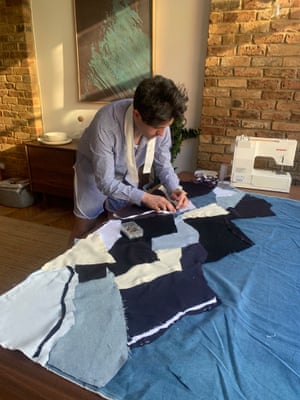 "Ever since the show, I've been inundated with requests to make similar quilted items, so I thought this was a good opportunity to show people how they can do so themselves. "You can make it from any leftover fabrics you have. This time, I used some leftover damaged denim from my studio as the quilt base. I don't imagine everyone has that lying around so use what you have. "Heavier is better for the base so it can hold the appliqué – maybe some old curtains or an existing blanket that needs some love. If you don't have enough to do a blanket, you could use the same technique to make a cushion. For the appliqué, it could be old clothes, tablecloths, tea towels – anything you can get your hands on. "I went quite abstract with my pattern, but you could come up with a more elaborate design. "Mine took me five hours on a sewing machine. You could hand sew it instead. It's going to be a much longer process but could be very therapeutic, which is something we could all do with right now." 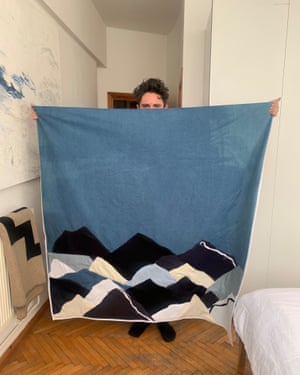 Difficulty level: intermediate How to: "For the nitty-gritty, head over to my Instagram – my wonderful sister captured the whole process."
Crochet a small rug with menswear designer Liam Hodges Liam Hodges has recently moved house, so his time in self isolation has been spent unpacking and making rugs. "I learnt to crochet last October and have found it really relaxing. For our AW20 collection, we crocheted a lot of squares as embellishments. I've kept it up and even tried to make a skipping rope when I first went into isolation. "I had been wanting to make some rag rugs and started working out how to crochet graphics into them. I made the graphic in Photoshop so that each pixel represented each crochet stitch. 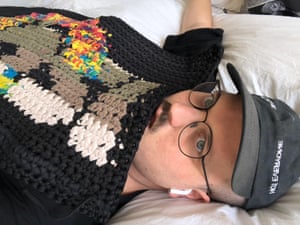 "I thought doormat-size was perfect. I have mine by the door to remind me to keep positive and take the [government] advice about staying in seriously. "It took me around two and a half hours to complete and is made up of old, shredded T-shirts for the coloured section and yarn made using Wool and the Gang offcuts for the main black areas, so it is entirely made from waste." Difficulty level: intermediate How to: "Use our how-to digital zine on Instagram, which has the pattern as well as instructions on how to crochet." 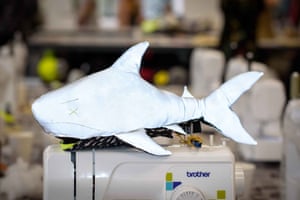 Designer Christopher Raeburn's team are adapting to the current situation by releasing weekly creative tasks via their #RaeburnAtHome initiative. "This project is to make one of our shark mascots. We have always featured animals in our collections, initially as a way to highlight and support endangered species through our WWF UK partner. The Shark is one of our most popular animals; we keep it in our collections each season, but it always evolves. "You need no more than one square metre of fabric – even less if you are conscious of pattern placement for waste reduction. Using a variety of smaller cuts of fabric is encouraged though as this adds pops of colour and texture to the final shark. "Not only is reusing and repurposing old fabric a more interesting way of working, but extending the lifetime of garments is instrumental in reducing planetary impact. When people are spending more time at home than ever before, now is the chance to pull out those bits that we no longer use and give them new life. "Unless you are an absolute master, it should keep you busy for about 10 hours. We only recommend a sewing machine for ease and speed – top marks for effort go to anyone tackles it by hand." Difficulty level: advanced How to: For the full instructions click here; you can download the shark pattern here. It is designed to fit on A4 paper. Sew a kimono-inspired garment with designer Edward Crutchley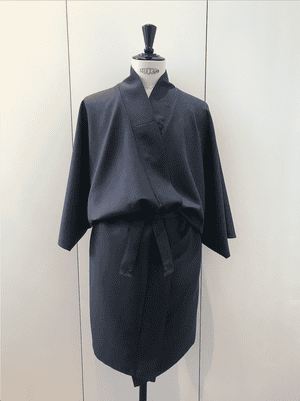 Designer Edward Crutchley's lockdown aim is to set himself a project each day. His first was to cut a pattern for and sew a one-piece kimono-inspired garment. Next up is making miniature sculptures of the kings and queens of England using modelling clay. "How to make Japanese clothes by John Marshall is a book I have on my shelf that I thought it would be great to lose myself in during isolation. "I love traditional Japanese clothing and now is the perfect time to study. What I love about kimonos is that they are traditionally dictated by the fabric – they are the width they are because that is how wide the looms could weave. For a fabric geek like me, that's a dream. "A traditional kimono pattern looks like some different-length rectangles put together, but nothing is ever that simple and it takes a lot of skill to construct a traditional kimono properly. The one I made is much, much easier. "I used three metres of fabric left over from the last collection, but you could make it with two metres if it's 150cm wide, or you can easily add seams to the patterns or patchwork fabrics together. Repurposing old curtains or a bed sheet would be perfect. "It took me around four hours to complete – there are only three seams and three hems. I tried to make it as simple as possible." Difficulty level: advanced How to: "The pattern I made is available to download for free here. The step-by-step sewing guide is saved on my Instagram highlights." Make a shrunken crisp-packet necklace with Tatty Devine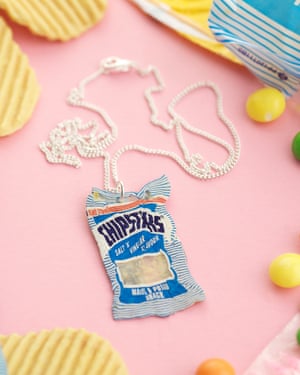 While social distancing, Rosie Wolfenden and Harriet Vine, the designers behind Tatty Devine jewellery, are doing daily making challenges. "It's amazing for your mental health and the perfect antidote to these strange and unsettling times. This so-called shrinky necklace is something we did as kids. We first made one as Tatty Devine in 2001. It was very early days, when we made jewellery from whatever we could get our hands on. We enjoyed having to eat crisps." Difficulty level: beginner How to:
You can stop with one pendant or layer up for a charm effect. Knit a scarf with dancer Meshach Henry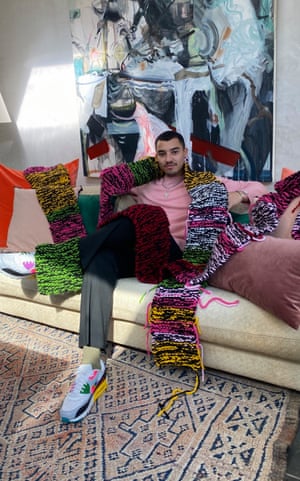 Despite having no previous knitting experience, dancer Meshach Henry has made three scarves in as many days, documented on Instagram by his partner, the Radio 1 DJ Nick Grimshaw. "I always said I would learn a new skill like plumbing or plastering if I ever had a lot of time on my hands. But they aren't ideal skills to practice in this current situation. So, having seen knitting supplies in a craftshop window recently, I thought, 'Here's my new hobby.' "I purchased a thick wool because it looked easier to use and less fiddly. I bought 10mm knitting needles, which I thought were an average size but later found out are strangely big – but I'm really happy with the chunky effect they produce. "What I like about knitting is that you can see your physical product. As a dancer, I rarely get to see my own work, so to be able to see and hold this tangible thing is a whole new world for me. "My intention is to move on to knitting jumpers. I want to create a matching jumper for every scarf, just to keep things interesting." Difficulty level: beginner How to: "I taught myself by watching an eight-minute Knitting for Total Beginners tutorial on YouTube. The tutorial taught me how to cast on in the first instance. Then there are follow-up links to a second video that teaches you how to change knitting style and how to cast off." 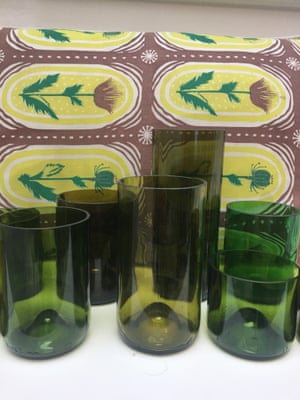 Lucinda Chambers is co-founder of fashion brand Colville and online shopping platform Collagerie and was fashion director at British Vogue for 25 years. "I was in Paris six months ago having a glass of water in the Bon Marché and I noticed the glass looked suspiciously like the end of a wine bottle." When Chambers investigated she found a world of home crafters making their own tumblers from pre-used wine bottles. "I found an inexpensive kit on Amazon," she says. "Each glass is a labour of love as I sand them by hand; it's strangely therapeutic." Difficulty level: medium How to: "The kit has everything you need to make the glasses: a stand, saw and markers that you place on the empty bottle at the height you require your finished glass to be. You can make French-style low tumblers or something taller. Once you've cut the bottle you need to sand the cut edge smooth." The internet is full of videos, such as this one, that show you more details. |
| Net-a-porter Delivery Fleet Swaps Fashion for Food in Charity Effort - WWD Posted: 31 Mar 2020 01:48 AM PDT LONDON — They are a fixture of the central London landscape, and now they are attempting to do their bit for those suffering from the coronavirus. The small Net-a-porter transport vans that, under normal circumstances, zip around town delivering luxury fashion have been donated to seven local Age U.K. charities in London. The fleet, emblazoned with the phrase "Fashion that delivers," will be used to transport supplies to vulnerable, socially isolated people. "During this critical time, these charities are working tirelessly to ensure that elderly and vulnerable groups have access to essential care packages, food and medical supplies, while they are required to stay at home," the company said, adding the vans will be made available immediately in response to the "unprecedented level of need" which is challenging charity resources. They will ferry food and medicine to older people living in the London boroughs of Kensington and Chelsea, Hammersmith and Fulham, East London, Enfield, Camden, West London and Lambeth. "Now, more than ever, the primary focus of our colleagues and customers is the well-being of relatives, friends and communities. Reflecting our core sustainability priorities, the group hopes that the redistribution of these resources will help to make a difference in London," the company said. The e-tailer has also been making efforts in Italy, which has been the worst hit by COVID-19. It has donated laptops to Italian schoolchildren and created digital education content packages for Italy's Ministry of Education to help with home schooling. As reported last week, Net-a-porter said it was temporarily closing its London warehouse in line with similar temporary closures it has made in Europe and the U.S.A., until further notice. The closures are understood to have been planned in stages. Following an order issued by New Jersey Gov. Phil Murphy that applies to most businesses in the state, Net has temporarily suspended activities in its local distribution centers there and is understood to be looking into alternative ways to serve customers. |
| What are you wearing while working from home? - The Guardian Posted: 31 Mar 2020 06:53 AM PDT  With many people forced into working from home by the current situation, the question of what to wear to the office has suddenly morphed to become what to wear to work in my kitchen, bedroom or living room. Sartorially, it can mean very different things to different people. For some it will make sense to dress even more smartly than you might to the office, via pinstripe shirts and proper shoes. For others it will mean dressing for work with your top half, the sofa with your bottom half; otherwise known by a multitude of other names: "conference call dressing", "dressing from the top up", "telecommutercore" and "news anchor dressing". What about you? Show us your best WFH outfits, whatever that means to you. Share your photosAre you seeing it as a chance to make any old Monday, Tuesday or Thursday, Wednesday feel like a dress-down Friday? Or a chance to practice power dressing from the confines of your front room. Or if you are one of those who has unfortunately lost their job because of the uncertainty the coronavirus has brought with it, what are you wearing to look for new jobs or update your CV? You can get in touch by filling in the form below. Your responses are secure as the form is encrypted and only the Guardian has access to your contributions. One of our journalists will be in contact for publication before we publish, so please do leave contact details. If you're having trouble using the form, click here. Read terms of service here. |
| What Can the World Learn From Shanghai’s First Online Fashion Week? - WWD Posted: 30 Mar 2020 02:24 PM PDT Shanghai Fashion Week's online experiment in partnership with Alibaba's Tmall came to an end Monday evening. As the first purely digital fashion week, it provides valuable insights and lessons for brands and fashion week organizers around the world to rethink their strategies amid the coronavirus outbreak, especially when fashion weeks over the summer have all been canceled. Some 150 brands showcased their fall 2020 collections while selling items from the current season via livestreaming to Tmall's 800 million active users. Over 2.5 million people watched the fashion week's opening ceremony, and 6 million watched the shows on the first day. Women from the ages of 26 to 35 living in first- and second-tier cities made up three-quarters of the audience. Bringing a fashion showcase online has some obvious benefits. One does not need to worry about seating capacity, it can be done at a very low cost, and brands can cash in instantly. "There is no limit to the number of fans, clients, press and new eyes that you can have on your work with this format. We had a little more than 3,000 tuned into ours, and it's helpful to imagine what a stadium of that many fans would look and sound like in real life," said Joshua Hupper, cofounder of Babyghost. The brand also included a makeover session and a panel talk following the showcase. Their effort seemed to pay off. Sales coming from livestreaming jumped 450 percent from the brand's daily streaming.  Screenshots of livestreaming from Private Policy, Shushu/Tong and 8on8 during Shanghai's online fashion week. Screenshot But those looking for a total replica of the physical experience will be deeply disappointed. The online fashion week, which happened under very specific circumstances in a very short period of time, went with a consumer-facing angle. Most brands tapped into Tmall's mass-market focused livestreaming ecosystem with little modification. A small number of them managed to come up with innovative, entertaining and well-executed livestreaming experiences. Short films, chat shows, performances, and models walking down the virtual runway while a salesperson interacts with the audience, like what one sees on QVC, were some of the most common formats for brands to fill their streaming slots, lasting from one hour to half-a-day. Some kept it highbrow. Shushu/Tong was the only one that skipped the selling part, putting its well-produced fashion film, which was only shot a week ahead of the streaming time, on repeat, while Ffixxed Studios arranged a group of friends to dress up in its fall 2020 collection to fully bring their quirky fashion presentation experience online. Fiona Kain of Ffixxed Studios told WWD that they looked at a bunch of different livestreams from different brands to understand the format before deciding what direction they are heading. "We didn't see a lot of people deviating from the more traditional livestreaming format but we thought it would be an interesting thing for us to try. We chose not to go down the path of hardcore selling, and instead, we wanted to do something more fun and entertaining, and a little more unexpected, a bit like a parody," said Kain. "There were of course still some products for sale in the Tmall store, but we sort of integrated the selling part into the 'show'.' I think for the technical side it's worthwhile getting a good production team that has experience with livestreaming, and as for content, we at least feel it's really worthwhile actually thinking about how to represent the brand, or how to do something a little bit differently. It's a really good opportunity to connect with your audience as well as a whole new, much larger audience in China," she added. Gong Li of men's wear label 8on8 thinks going digital is a significant step for independent designers to understand the Chinese online retail system. "For me, selling is the main goal. It will be a waste of resources if you cannot generate any revenue," he said. Meanwhile, Sans Peng, cofounder of Untitlab, a designer shoe brand, believes accurate casting and a good script are key to the success of a good livestreaming session. "Don't skip rehearsal and don't just sell goods. It's a good opportunity to convey brand identity," he said. Knitwear designer Xiao Li sees the streaming slot as a vehicle for storytelling. "Our price point is too high for Tmall's audience at the moment, but it is a good platform to share stories behind the scene. In the future, however, I believe having a Tmall presence will be essential," she said.  Behind the scene of Ms Min's livestreaming during Shanghai's first online fashion week. Courtesy Photo Ms Min, a Xiamen-based designer brand started from Taobao by Liu Min 10 years ago, kept the selling experience unique, genuine and on-brand. Instead of hiring generic presenters who had no idea what the brand is about, a mistake a majority of the brands made, Ms Min gathered a set of women who embody the essence of the label, and built the set with a grass-covered floor, dried coconut tree leaves as the background and professional lighting and filming equipment, setting itself apart from those who streamed via phone in front of a white wall with bleak indoor lighting. Ian Hylton, chief executive officer of the brand, said: "Streaming is not about standing on an elevated stage looking down or projecting fantasies. It's about sitting beside them listening to their needs and creating a respect-based dialogue. It needs to have a combination of brand integrity and technical integration. When the client can not touch, they need to feel the message of the collection and understand the emotion of the collection and the designer's vision. When people feel, they engage." All is possible, thanks to Tmall's mature ecosystem bridging livestreaming, e-commerce, consumers, brands, technologies, logistics, financing and entertainment in one mobile application. Anyone can have access to the online fashion week by simply searching "cloud fashion week" in the app. Livestreaming is a common tool available in a wide range of social media platforms, such as Instagram, Twitter and Facebook, but there is no other app that matches the capabilities and ease of use of Tmall. "It cannot be easily copied outside of China. You can borrow the format, but the sheer number of viewers and buying enthusiasm are elements unique to the China market," said Siying Qu, cofounder of New York label Private Policy. The brand invited industry friends to host its session in Shanghai, while she and her business partner Haoran Li stayed in New York self-quarantined. "Livestreaming fashion week is definitely worth the time to carefully research and test for. It is the most low-carbon fashion presentation we ever could achieve, but also the most intimate we have ever experienced with more than 12,000 fans at once within the one-hour event. This was just unthinkable before, without a huge budget, unaffordable for a newly established brand under such harsh economic conditions due to the COVID-19 impact," she added. That being said, livestreaming is also a challenging format for designers. The competition is transparent and immediate. Your event popularity and sales report are for everyone to see live, and you will be competing with other countless livestreamers, selling everything from designer knockoffs to real diamonds. Alice Xu, founder of fashion jewelry brand OOAK, advised that "brands need to have a narrative and stay focused on the key points, as the viewers' average time spent in your livestreaming room is only less than a minute," and "keep an eye on the comments section and be interactive with the viewers."  Le Fame replicated a classic China household's interior from the Eighties for its livestreams. For Shanghai-based fashion brand Le Fame, the COVID-19 outbreak has been a catalyst for online expansion. On top of asking professional TV anchors to host their well-curated livestreams, Le Fame also recently launched on the WeChat mini-program. Manxiu Wang, cofounder of the label, said: "The city lockdown, factory closure, cancelation of orders in the past three months have forced us to execute our digitization plan for the next two years within two months. I think many brands in the West will have to do the same now, or they won't survive." Despite a structural difference in the digital ecosystem between East and West, Bohan Qiu, founder of communication agency BOH Project, who hosted several livestreams for designer brands, believes Western brands can learn to adapt what has happened on Tmall to social platforms like Instagram, YouTube or even Tik Tok to create new and engaging content in the coming months. "I do feel that instead of resisting it, we need to take more of a leading role. Obviously it's still tricky to retain the full artistic vision of a brand's creative universe in this format. But the matter is not about how most average brands do it, but about how much better, more creative and engaging you can make it. Perhaps a more artistic approach combining CG, AR or VR technologies to showcase true design, creativity and the fantasy aspect of fashion needs to continue to create, should still be something we work collectively towards," he added. Tasha Liu, founder of Labelhood, which organized 42 livestreams for 31 designer brands during the online fashion week, said: "I can assure you physical fashion shows won't be replaced by the online showcase. What matters is the quality of the content. Livestreaming is a tool. I am glad to see that our designers are being super innovative and keep pushing the boundary on what a virtual fashion experience can be." Ian Lin, founder of trade show Shanghai Showroom, and a fashion critic, offered his take after a week of browsing through fashion livestreaming via his phone: "I used to complain that it's such a waste of time to catch one show after another. Now, with physical shows gone, I miss them terribly. What's missing is the sense of ritual and commitment, the ceremonial aspect of it, the fact that you have to sit through the whole thing, whether you like it or not." Tera Feng, an influencer who also hosted several livestreams, believes eventually online and offline fashion experience will form a symbiotic relationship. "It's just like online and offline retail or print and digital media. They are not enemies, but two sides of one coin. The online showcase demonstrates new possibilities that can empower the physical fashion experience, and help brands to reach a far wider audience. Eventually, it helps the industry to evolve and survive this difficult time," she concluded. You May Also Like |
| You are subscribed to email updates from "fashion" - Google News. To stop receiving these emails, you may unsubscribe now. | Email delivery powered by Google |
| Google, 1600 Amphitheatre Parkway, Mountain View, CA 94043, United States | |




0 Yorumlar